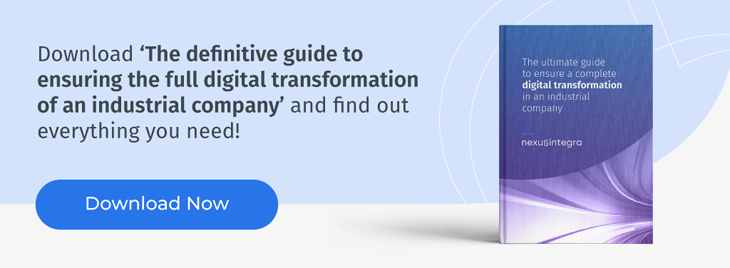Before starting a project to implement MES and MOM systems in an industrial company, it is recommended to perform a functional analysis that comprehensively describes the company’s needs on a global basis.
The success or failure of this project will depend on the correct definition of the production requirements, and the study of these needs will serve as a guide to define the scope, objectives and approach of the subsequent implementation.
In addition, performing an analysis prior to the implementation of MES and MOM systems will serve to measure its performance and follow its evolution.
In this article we will discuss what MES and MOM systems are in the industry and give the keys to implement such a project.
What is an MES system?
In short, we can define an MES system as a system that allows better real-time management of production, while providing detailed visual data and information of great value for decision making. In our article MES System, what is it and how does it work? we delve in detail into MES systems and how they work in Industry 4.0. Knowing how it works, the objectives and the benefits of its implementation in a company in the industrial sector creates an operational advantage.
What is a MOM system?
To understand what a MOM system is, we first analyze its acronym, which stands for: Manufacturing Operations Management. Which in English translates as manufacturing operations management.
A MOM system is an integrated management system that offers an expanded and generic view of all the processes involved in the production process of a company. This system takes into account from the production plants and maintenance operations to the logistics operation of the entire organization.
It is, therefore, a system that helps to establish policies and regulations necessary to maintain the value of production, ensuring that everything, including employees, works correctly and in a synchronized manner.
One of the advantages of the MOM system is that its operation is based on KPIs common to all areas of the company. This is its main strength and differentiating agent, since it is capable of constantly improving the performance of the organization at a “macro” level.
To finish understanding what a MOM system is, it is necessary to talk about its relationship with a MES system. It is difficult to distinguish between MES systems and MOM systems, especially if we take into account that they are born from the same idea and have the same common objectives: to streamline tasks, improve productivity, reduce costs, facilitate the execution of actions, prevent errors and predict results in order to prevent them. However, we can affirm that the MOM system was born as a more complete and wider-ranging version of the MES system.
Keys to the selection and implementation of MES and MOM systems
It seems logical to perform an analysis prior to the implementation of any type of change in a company. However, when it comes to digitizing the industrial sector through MES and MOM solutions, this analysis takes on greater relevance. The changes that occur in the industry require a greater economic investment than in other sectors, due to the large number of complex assets involved in its operation.
Some of the recommendations and keys for the implementation of MES and MOM systems include the following basic points:
- Define needs. In this phase, each element of the intervention value chain is thoroughly analyzed, from the machine, the operator or the existing solutions and/or systems. A correct definition of the needs is key to advance in the decision to implement a project of this nature. Therefore, in this first phase it is very important to reflect and define the needs of the company.
- Global vision of the industry. Understanding the current state of the industry at a global level and being able to see the specific circumstances of the industry and the factory within this environment is vital to define the project. By observing how other companies handle their digitization, you can know where the business opportunities lie and adjust the requirements accordingly.
- Understand your own characteristics. A proper analysis must continue with an understanding of the physical processes and their workflows in order to define them properly at a numerical level and digitally. Therefore, we cannot rely on a standard list of key points, but must be able to understand the unique characteristics of the business to understand its peculiarities, and from this, achieve total plant integration.
- Use of an interface. Employees must be able to work in one interface, regardless of the task at hand, and easily find the data source they need at any time. At this point, it is also necessary to track the routes taken by operators and see what actions they are performing at any given time through task monitoring.
- Integration of all the company’s management systems. It is important to collect physical signals in the factory, as well as the distribution of information in all areas of the company. To develop a good digital transformation plan, all areas of the company must be connected to each other through the same interface. Any area of the company must have access to what is happening on the shop floor in real time. MES and MOM systems allow operational management in the plant through a multiplatform interface.
- System allied with the operators. The MES/MOM tools should be a working ally for plant operators, maintenance personnel, quality, supervisors and all employees in each of the analysis phases. During the functional specification stage, consideration must be given to how the plant actually works, how operators move around the factory, how they use the machines, how and when they communicate or report information, and what data they need to have visible at any given time and in each process. It is vital that the project is adjusted to each of the real needs of the operators and machinery in the factory.
What has been explained so far is based on the experience of the processes of analysis, decision making and implementation in situ in the factories. We must be clear that the implementation of the MES and MOM system alone does not solve all production problems, but they do provide the necessary tools to solve these problems through the management of manufacturing orders and stock, through the control and monitoring of the processes in the production plants.
Enhance your MES and MOM systems with Nexus Integra
In conclusion, preliminary analysis is a key requirement for the successful implementation of MES and MOM systems. By evaluating all the possibilities, needs and resources available to the production plant, the project can more easily become a true digital transformation and achieve the expected benefits that these systems bring.
To cope with increasingly complex operational systems and data sets, MES and MOM systems can be powered by an integrated operations platform with an IoT and Big Data solution to achieve a global, connected and fully automated operations environment.
If you already work with SW solutions such as MES, MOM or CMMS, contact us so we can tell you how to connect your application with our integrated operations platform and have your production data governance centralized.


